 |
| Personal Preparedness |
|
| |
|
|
|
| |
Scientific Approach to Local and State Emergency Response
- Understand evolution of local governance and emergency response institutions
- Local history and political science
- ‘Lessons Learned’
Understand evolving social structure of local communities
- Sociology
- Social and cultural anthropology
|
‘All Crises Begin Locally’
- Initial management burden is local
- Local and regional assets must be adequate for response
- Mitigation time may be critical (e.g., HAZMAT or fire control)
- State and Federal resources take time to engage
- Chain of command
- Transportation and Mobilization time
- Communications and transportation may be disrupted by crisis
|
Local Assets and Event Phases
Man-made or natural event recognized at onset
- Warning Phase: Threat Recognition
- Crisis Response Phase: LOCAL ASSETS
- Surge Phase: Mutual aid supplements local assets
- Recovery Phase: Return to normal
|
|
Agent- and Response-Generated Demands (Dynes, Quarantelli and Kreps 1981)�
|
Agent-generated demands (generated by event)
- Warning
- Pre-impact preparations
- Search and rescue
- Care of injured and dead
- Welfare demands
- Restore essential services
- Protect from continuing threat
- Maintain community order
| |
Response-generated demands
- Communication
- Continuing situation assessment
- Mobilize and utilize human and material resources
- Coordination
- Establish and maintain control and authority
|
|
‘All Crises Begin Locally’
- The most local social unit is the individual and family
- Personal preparedness = household preparedness
- Degree of personal preparedness determines the magnitude and scope of both agent-generated and response-generated demands
|
|
Agent- and Response-Generated Demands (Dynes, Quarantelli and Kreps 1981)�
|
Agent-generated demands (generated by event)
- Warning
- Pre-impact preparations
- Search and rescue
- Care of injured and dead
- Welfare demands
- Restore essential services
- Protect from continuing threat
- Maintain community order
| |
Response-generated demands
- Communication
- Continuing situation assessment
- Mobilize and utilize human and material resources
- Coordination
- Establish and maintain control and authority
|
|
|
Factors Determining Preparedness Behavior
|
Citizen Corps ‘Preparedness Model’
- Based upon 2 approaches from social sciences:
- Extended Parallel Process Model
- Stages of Change/Transtheoretical Model
|
Extended Parallel Process Model
Extended Parallel Process Model Perceptions
- Perception of Threat determined by:
- Threat severity (How ‘bad’ are the consequences?)
- Threat susceptibility (Will it happen to me?)
- Perceived value of protective action
- Self-efficacy (Can I prepare?)
- Response efficacy (Will preparation help?)
- Extended Parallel Process Model actions
- Danger control: solution to threat
- Believes that an effective response is available (response efficacy)
- Capable to use the response to reduce the risk (self-efficacy)
- Fear control: not solution-oriented
- Denial
- Rationalization
- Escapism
|
Citizen Corps ‘Preparedness Model’
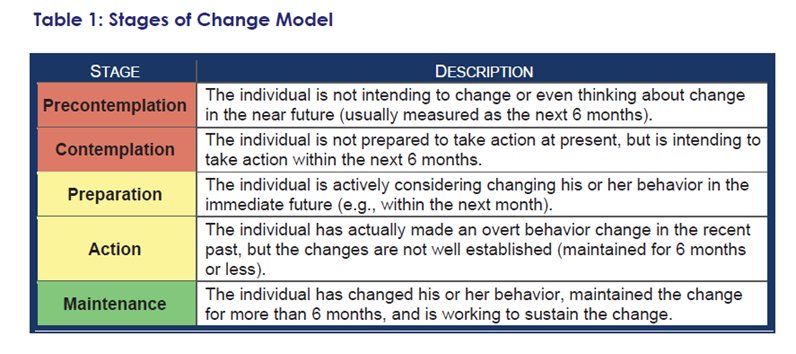
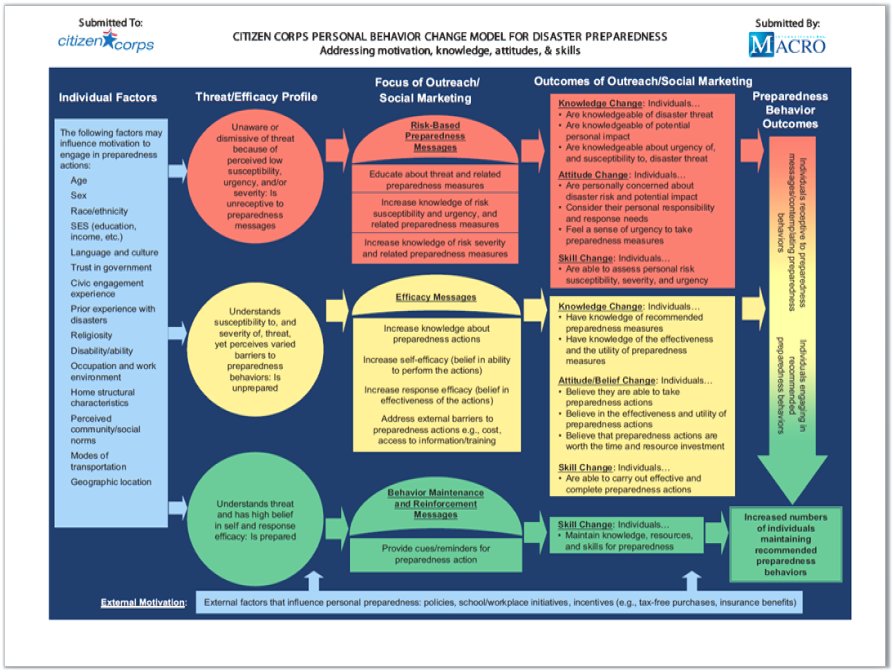
|
Personal Preparedness: Factors
- Personhood factors
- Personality, values, behaviors, etc.
- Quantitative factors about person
- Socio-economic status
- Education level
- Societal norms and values
|
Personal Preparedness
- Motivation linked to traditional value of self-reliance
- Frontier-based romanticism of self-reliant explorer, trapper, rancher, cowboy, settler, etc.
- Mirrored Victorian values of self-help
- Personal responsibility and self-sufficiency as defining features of American culture
|
Personal Preparedness and Historical Values
- Reconciliation with “You are your brother’s keeper”
- ‘Christian charity’ and ‘good works’
- Communal identity
- Concept of ‘greater good’
- Selflessness
Personal Preparedness and Historical Values
- “… ask not what your country can do for you, ask what you can do for your country.”
- Freedom:
- Empowers individuals to work for the common good of affinity groups
- Personal obligation to use freedom responsibly
|
Personal Preparedness: 20th Century Self-Sufficiency and Altruism
- WWII
- Victory Gardens
- Compliance with rationing and self-denial
- War bonds
- Cold War
|
Personal Preparedness and Post-WWII Values
- Anti-hero in popular culture
- Freedom from coercion by ‘society’
- Self-determinism
- “I am the captain of my fate…”
- Freedom as lack of encumbrance or engagement
- “Freedom’s another word for nothing left to lose…”
- “… it’s a hard, lonesome, cold world…”
- Isolated and Alienated
- Right to Privacy
- “Inalienable Right to Be Self-Destructive?”
- Limits on ‘freedom’: Insight into societal values
- Involuntary commitment
- Pre-trial incarceration for criminal proceedings
- Registration laws for convicted pedophiles and sex offenders
|
Involuntary Commitment and Personal Freedom
(http://www.alleghenycounty.us/dhs/commitment.aspx )
- Pennsylvania Code: http://www.pacode.com/secure/data/055/chapter5100/chap5100toc.html
- Request emergency evaluation and treatment for a person who is dangerous to themselves or others due to a mental illness.
- Allegheny County (http://www.alleghenycounty.us/dhs/commitment.aspx)
- Danger to self shown by establishing that within the previous 30 days:
- (1) the person would be unable without the care, supervision and assistance of others to satisfy his/her need for nourishment, personal or medical care, shelter or self protection or safety and that death or serious physical debilitation would occur within 30 days unless treatment was provided;
-
Danger to self shown by establishing that within the previous 30 days:
-
(2) the person has attempted suicide or the person has made threats to commit suicide and committed acts in furtherance of the threats; or
- (3) the person has mutilated himself/herself or the person has made threats to mutilate themselves and committed acts in furtherance of the threats.
-
Danger to others shall be shown by establishing that within the previous 30 days the person has inflicted or attempted to inflict serious bodily harm on another or has threatened serious bodily harm and has committed acts in furtherance of the threat to commit harm to another.
|
Limits on Personal Freedom (http://www.alleghenycounty.us/dhs/commitment.aspx)
- Clear and present danger
- Others
- Self
- Euthanasia?
- Voluntary physician-assisted suicide?
- Ambivalence about coercion
|
Personal Preparedness and 21st Century Values
- Narcissism?
- Failure to take responsibility
- Sense of entitlement
- Blame others / scapegoats
- Lack of empathy
|
|
Personal Preparedness
|
Personal Preparedness
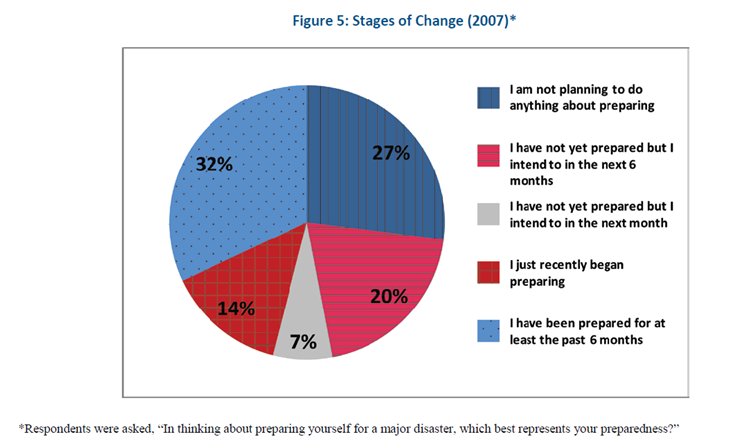
|
Personal Preparedness
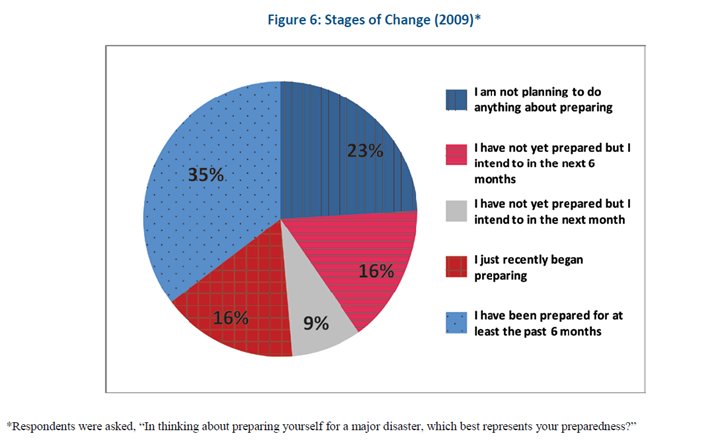
|
Personal Preparedness

|
Personal Preparedness
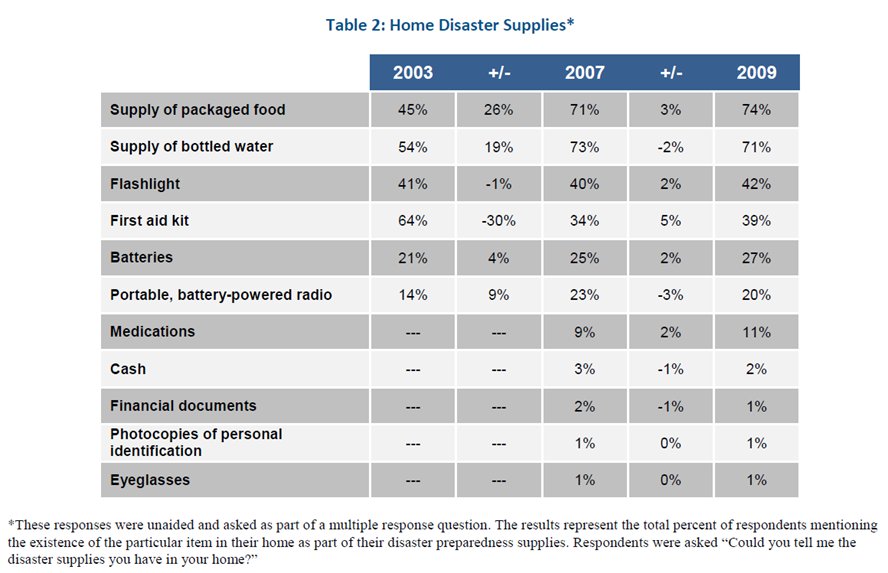
|
Personal Preparedness

|
Reliance on others
http://www.citizencorps.gov/downloads/pdf/ready/2009_Citizen_Corps_National_Survey_Findings.pdf
- Women were significantly more likely to rely on household members and people in their neighborhood (61% and 29%, respectively), than men (49% and 24%, respectively).
- Women (49%) were significantly more likely to report needing help to evacuate or get to a shelter than men (35%).
- Rural residents (30%) were significantly more likely than suburban individuals (24%) to rely a great deal on people in their neighborhood in the first 72 hours of a disaster.
- Black individuals were significantly more likely to rely a great deal on their faith-based community (40%) or nonprofit organizations (34%) in the first 72 hours of a disaster than White individuals (22% and 17%, respectively).
- Hispanic individuals (30%) were significantly more likely to rely a great deal on nonprofit organizations than non-Hispanic individuals (19%).
- Blacks (67%) were significantly more likely to expect to need help to evacuate or to get to a shelter than Whites (36%).
- Households earning less than $25,000 expected to rely on state and federal government agencies (28%), as well as fire, police, and emergency personnel (45%) in the first 72 hours of a disaster than those earning more (17-19%, and 34-36%, respectively).
- Additionally, these individuals were significantly more likely to need help evacuating or getting to a shelter (59%).
- Individuals with only a high school education (31%) were significantly more likely than individuals with college experience (25%) to rely on people in their neighborhood.
- Individuals without college experience more likely to rely on state and federal government agencies (28%), as well as emergency response personnel (48%) than individuals with college experience (17% and 34%, respectively).
- Very religious individuals were more likely to rely on their faith-based communities (45%), household members (60%) and nonprofit organizations (24%) as compared to those who are barely or not at all religious (7%, 51%, and 14% respectively).
|
Personal Preparedness
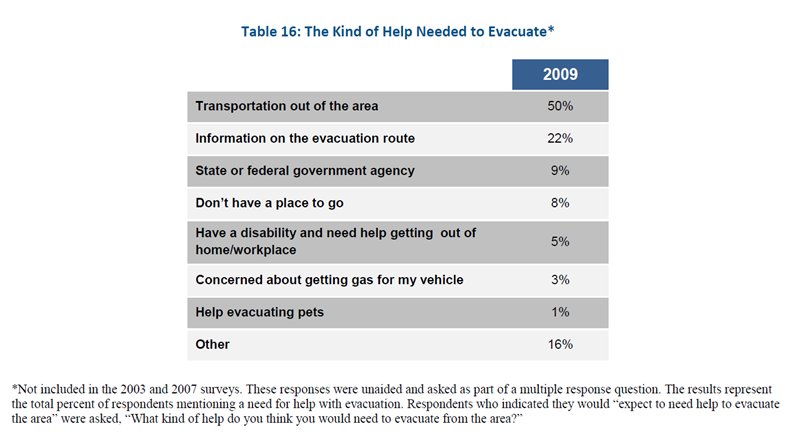
|
Personal Preparedness
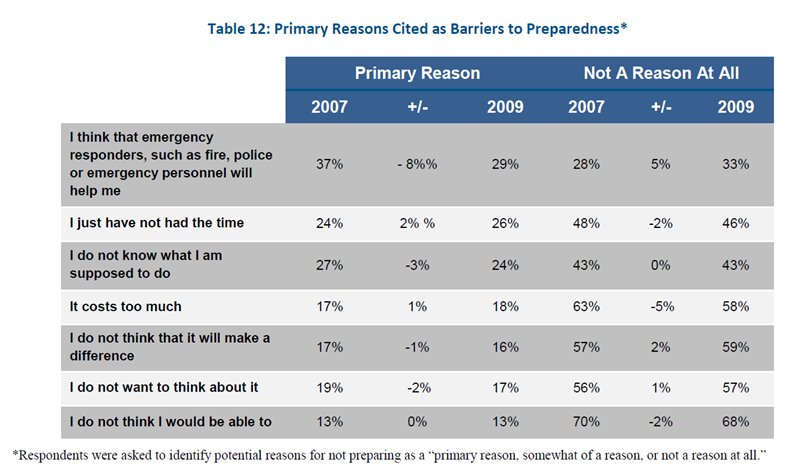
|
Personal Preparedness
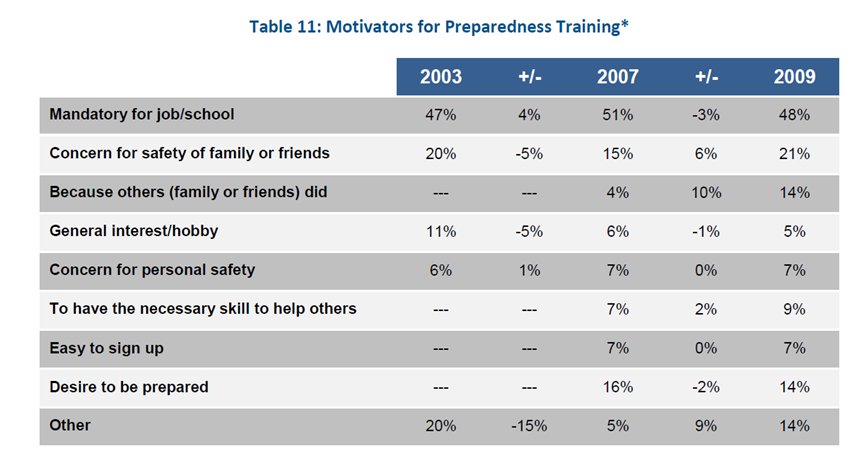
|
Personal Preparedness

|
|
http://www.citizencorps.gov/downloads/pdf/ready/2009_Citizen_Corps_National_Survey_Findings.pdf
li>“Very religious individuals (40%) were more likely than somewhat (33%) and barely or not at all (31%) religious individuals to have talked with others in their community about getting prepared. ”
Questions for Structured Discussion
How can we improve personal preparedness?
FEMA Model: Focus on Public Education and Marketing to foster preparedness in 2 groups
|
Questions for Structured Discussion
-
How can we improve personal preparedness?
- FEMA Model: Focus on Public Education and Marketing to foster preparedness in 2 groups
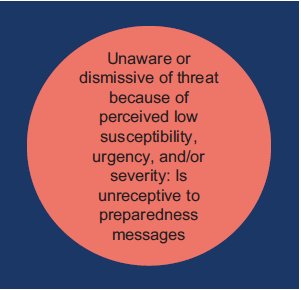 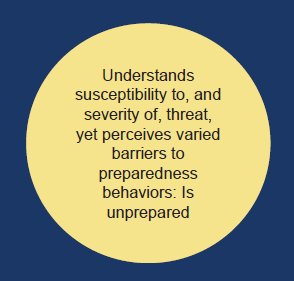
- Are these groups focused correctly?
- If we accept this model, how does one construct an effective preparedness education program?
|
Do health threat recognition programs modify behavior?
-
Smoking cessation: Expert system smoking cessation interventions, based on the same model, have produced only very modest evidence of efficacy (22-26% abstinence at 6 months). Velicer, W.F., J.O. Prochaska, and C.A. Redding, Tailored communications for smoking cessation: past successes and future directions. Drug and Alcohol Review, 2006. 25: p. 49-57
-
No better results from D.A.R.E. school-based drug abuse program (Pan, W. and H. Bai, A multivariate approach to a meta-analytic review of the effectiveness of the D.A.R.E. program. Int. J. Environ. Res. Public Health, 2009. 6: p. 267-27)
- No better results from school-based programs to combat obesity (Brown, T. and C. Summerbell, Systematic review of school-based interventions that focus on changing dietary intake and physical activity levels to prevent childhood obesity: an update to the obesity guidance produce by the National Institute for Health and Clinical Excellence. Obesity Reviews, 2009. 10: p. 110-141)
|
Questions for Structured Discussion
- Educational issue: Do we need to distinguish coercion (threat of ‘bad’ outcome) from enticement (threat of ‘good’ outcome) in formulating curricula?
- How can we improve personal preparedness?
- ‘Operational’ view: We need to plan for the current level of preparedness
- Few people will have supplies for 3 days or access to fuel
- There will be an expectation of assistance from responders
- Professional response agencies will be blamed for perceived shortcomings
|
|
| Copyright © 2011 - 2016 Carey Balaban |













